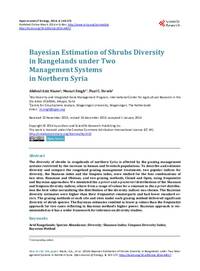Bayesian Estimation of Shrubs Diversity in Rangelands under Two Management Systems in Northern Syria

Authors:
The diversity of shrubs in rangelands of northern Syria is affected by the grazing management
systems restricted by the increase in human and livestock populations. To describe and estimate
diversity and compare the rangeland grazing management treatments, two popular indices for
diversity, the Shannon index and the Simpson index, were studied for the four combinations of
two sites, Hammam and Obeisan, and two grazing methods, Closed and Open, using frequentist
and Bayesian approaches. We simulated the a priori and a-posteriori distributions of the Shannon
and Simpson diversity indices, where from a range of values for a constant in the a priori distribution the best value normalizing the distribution of the diversity indices was chosen. The Bayesian
diversity estimates were higher than their frequentist counterparts and had lower standard errors. The grazing methods at each site and sites under each grazing method delivered significant
diversity of shrub species. The Bayesian estimates resulted in lower p-values than the frequentist
approach for two cases reflecting in Bayesian method’s higher power. Bayesian approach is recommended as it has a wider framework for inference on diversity studies.
